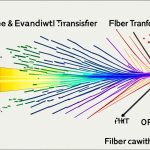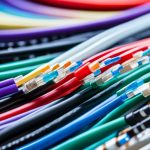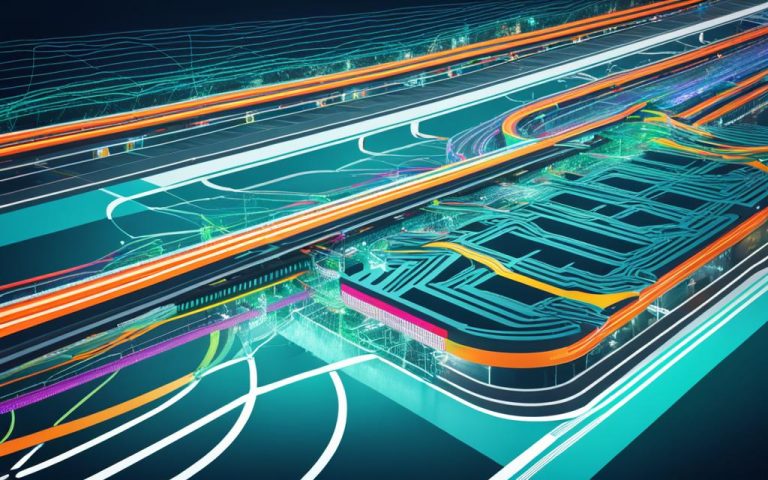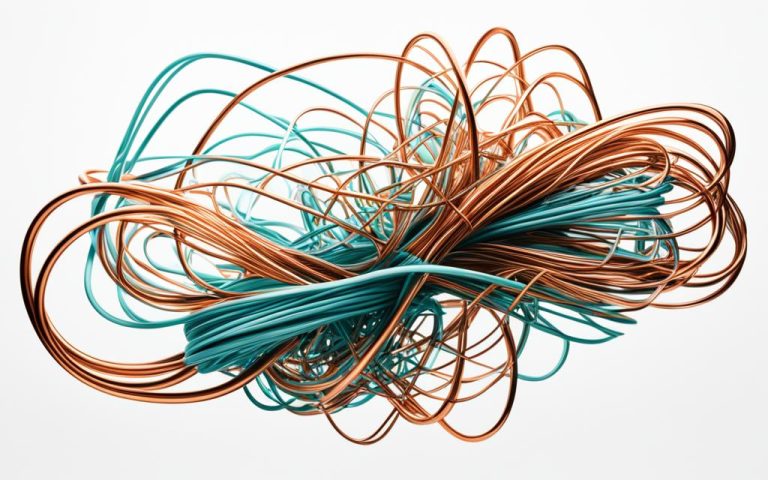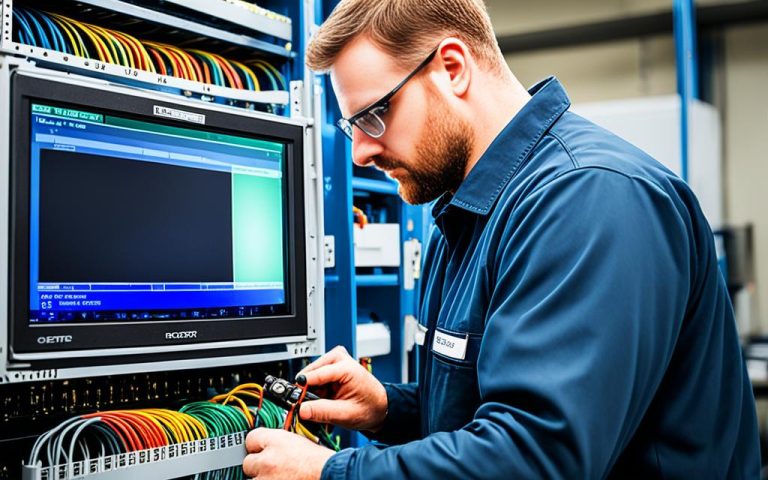Fiber optic technology has transformed the entertainment industry, revolutionizing the way we experience live events, gaming, and streaming. With its unparalleled speed and quality, fiber optics has become an essential component in delivering a seamless entertainment experience.
From powering high-definition channels in cable and satellite television to enhancing home theater systems, fiber optic cables have become synonymous with unparalleled picture quality and immersive entertainment. In addition, fiber optic internet has exponentially increased download speeds, allowing for uninterrupted streaming, seamless online gaming, and swift file downloads.
Beyond home entertainment, fiber optics has also had a significant impact on industrial automation by enabling precise measurements and control of industrial processes. Fiber optic sensors have revolutionized the manufacturing industry, leading to increased efficiency and productivity.
The continuous advancements in fiber optic technology have also accelerated research capabilities in fields such as physics, chemistry, and biology. From spectrometers to scientific instruments, fiber optics has opened up new possibilities for accurate and precise measurements, paving the way for further breakthroughs.
Furthermore, fiber optic technology has played a critical role in bridging the digital divide, extending high-speed internet access to rural and underserved areas. By investing in fiber optic infrastructure, governments and private companies are ensuring equitable access to digital resources and promoting social inclusion.
Fiber optic technology is reshaping the entertainment industry and our digital infrastructure. As technology continues to evolve, fiber optics will continue to revolutionize the way we experience and consume entertainment.
How Fiber Optics Works
Fiber optic cables, composed of thin strands of glass or plastic, are at the core of fiber optics technology. These cables transmit data in the form of light, facilitating high-speed and reliable communication over long distances. The key to fiber optics’ efficiency lies in the principle of total internal reflection, where light is bounced off the walls of the fiber core, ensuring minimal signal loss.
Fiber optics technology finds widespread application in various industries such as telecommunications, medicine, and industrial automation. The ability of optical fibers to transmit high-precision light signals over extended distances has made them an indispensable element in modern communication systems.
In the telecommunications sector, fiber optic cables enable the transmission of vast amounts of data at incredible speeds. This technology has played a vital role in the development of robust and high-performance networks, revolutionizing the way we connect and communicate.
Moreover, medical equipment and diagnostic devices harness the power of fiber optics to facilitate accurate and real-time information transfer. This enhances the efficiency of medical procedures and contributes to better patient care and treatment outcomes.
Fiber optics is also integral to industrial automation, where it enables seamless communication between machines, facilitating precise control and monitoring of industrial processes. By transmitting high-precision light signals, fiber optic cables contribute to increased efficiency and overall productivity in manufacturing environments.
Benefits of Fiber Optics Communication
Here are some key advantages of utilizing fiber optics for communication:
- Fast data transmission speeds, allowing for near-instantaneous transfer of information.
- Low signal loss, ensuring reliable and clear communication over long distances.
- Immunity to electromagnetic interference, reducing the likelihood of data corruption.
- Secure communication due to the difficulty of wiretapping fiber optic cables.
- Lightweight and flexible cables, making installation and maintenance more manageable.
- Compatibility with existing infrastructure, facilitating the transition to fiber optics technology.
Fiber optics has revolutionized the way we communicate and exchange information. Its ability to transmit data with unparalleled speed and reliability has transformed industries and pushed the boundaries of what is possible. With fiber optics, the future of communication and connectivity is brighter than ever.
Next, we will explore the numerous benefits of fiber optic internet and its impact on home entertainment.
Benefits of Fiber Optic Internet
Fiber optic internet has revolutionized the way we connect and communicate, offering a range of benefits that have transformed the digital landscape. With increased speeds and improved communication capabilities, fiber optic internet has become essential for businesses and individuals alike.
Increased Speed
One of the key advantages of fiber optic internet is its incredible speed. Compared to traditional broadband connections, fiber optic internet offers download speeds that are up to 100 times faster. This lightning-fast speed enables users to stream high-definition video, download large files, and engage in online gaming without any interruption or lag. Whether you’re streaming your favorite shows or participating in virtual meetings, fiber optic internet ensures a seamless and enjoyable online experience.
Improved Communication
Fiber optic technology has greatly improved communication by enabling data to be transmitted over long distances without any signal degradation. Unlike traditional copper-based internet connections, fiber optic internet uses light signals to carry data, ensuring signal integrity and reliability. This means that businesses can seamlessly communicate and collaborate across different locations, leading to enhanced productivity and efficiency. From video conferences to cloud-based communication tools, fiber optic internet has revolutionized the way we connect and communicate.
“Fiber optic internet has transformed our business communication. With its increased speed and reliability, we can seamlessly collaborate with clients and colleagues across the globe, making our operations more efficient and effective.” – John Smith, CEO of XYZ Company
With fiber optic internet, businesses and individuals can enjoy the benefits of increased speed and improved communication. Whether it’s streaming high-definition content or conducting seamless video conferences, fiber optic internet is revolutionizing the way we connect and communicate in the digital age.
Fiber Optics in Home Entertainment
Fiber optic cables have become an integral part of the home entertainment industry, enhancing the way we enjoy our favorite shows and movies. With their ability to transmit data at lightning-fast speeds, fiber optics have paved the way for high-definition channels and improved picture quality.
Whether you’re watching cable or satellite television, fiber optic cables ensure a seamless viewing experience with crystal-clear visuals. High-definition channels offer stunning clarity, bringing your favorite characters and stories to life in vivid detail. Say goodbye to pixelation and blurry images!
But the benefits of fiber optics in home entertainment don’t stop there. Home theater systems are also taking advantage of this technology, providing users with a truly immersive cinematic experience. From watching the latest blockbuster hit to enjoying a concert in your living room, fiber optic cables deliver the high-quality audio and video necessary to recreate the magic of the big screen at home.
The popularity of fiber optic technology in home entertainment is on the rise. More and more households are gaining access to fiber optic networks, allowing them to enjoy the benefits of high-definition channels and enhanced home theater experiences. As the demand for seamless, high-quality entertainment grows, fiber optics continues to play a crucial role in transforming how we enjoy our favorite content.
The Benefits of Fiber Optics in Home Entertainment:
- Access to high-definition channels
- Improved picture quality
- Enhanced home theater experiences
- Seamless viewing with no pixelation
- Crystal-clear audio and video
So, whether you’re binge-watching your favorite TV series or hosting a movie night with friends, fiber optics ensures that your home entertainment experience is nothing short of exceptional.

The Future of Home Entertainment:
“Fiber optics technology is transforming the way we enjoy entertainment in our homes, offering unparalleled speed and quality. As advancements continue, we can expect even more immersive experiences that transport us into the heart of our favorite stories.” – Industry Expert
With the growing demand for high-definition content, fiber optics will continue to shape the future of home entertainment. Stay tuned for even more exciting developments as technology evolves to meet our entertainment needs.
Impact of Fiber Optics on Industrial Automation
Fiber optic technology has revolutionized industrial automation, bringing new levels of precision, efficiency, and productivity to manufacturing processes. By utilizing fiber optic sensors, industries have experienced increased accuracy in measurements and control, leading to improved operational efficiency and reduced downtime.
The ability of fiber optics to transmit high-precision light signals over long distances has transformed the way industries approach automation. Unlike traditional wiring systems, fiber optics offer immunity to electromagnetic interference and can transmit data without loss or distortion. This enables seamless communication and real-time monitoring of critical parameters in industrial environments.
Fiber optic sensors are widely used in various manufacturing applications, including quality control, machine monitoring, and process optimization. These sensors provide accurate measurements of temperature, pressure, strain, and other parameters, ensuring the optimal performance of machinery and equipment. By continuously monitoring these variables, manufacturers can detect abnormalities and make immediate adjustments to prevent costly disruptions.
In addition to precise measurements, fiber optic technology also enables the control of industrial processes with unmatched efficiency. With fast and reliable data transmission, fiber optics facilitate rapid response times, allowing for seamless integration of different automation components and real-time adjustments to maintain optimal parameters.
The enhanced efficiency brought by fiber optics has resulted in significant cost savings for industries. By reducing downtime, improving productivity, and eliminating unnecessary maintenance, manufacturers can achieve higher output levels and reduce overall operational expenses.
| Benefits of Fiber Optics in Industrial Automation | Examples |
|---|---|
| Increased Efficiency | Real-time monitoring and control of industrial processes. |
| Improved Productivity | Seamless integration of automation components for optimized performance. |
| Cost Savings | Reduced downtime, maintenance, and operational expenses. |
The impact of fiber optics on industrial automation is widespread, extending to various sectors such as manufacturing, energy, and transportation. As industries continue to embrace digital transformation and seek ways to enhance efficiency and productivity, fiber optic technology will play an increasingly critical role in shaping the future of automation.
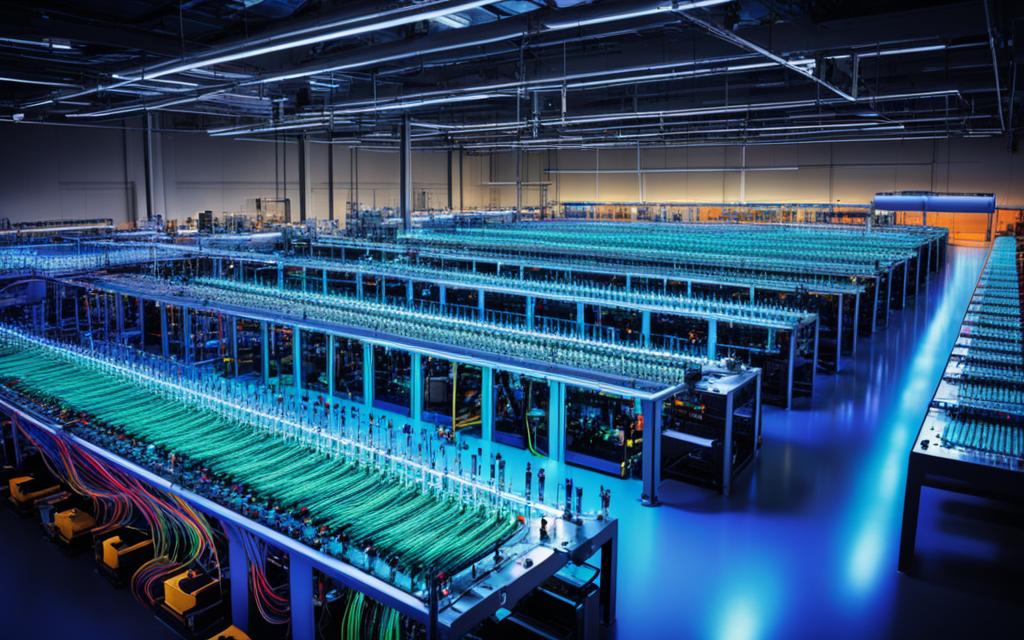
Fiber Optics in Research and Advancements
Fiber optics technology has made significant contributions to the field of research, enabling scientists and researchers to achieve more accurate and precise measurements across various scientific disciplines. By utilizing fiber optic cables in scientific instruments such as spectrometers, researchers can delve deeper into the realms of physics, chemistry, and biology, unlocking new frontiers of knowledge.
“Fiber optic technology has revolutionized the way we conduct research in the modern era. Its ability to transmit data with high precision and accuracy has paved the way for groundbreaking advancements.”
In physics, fiber optic systems are used in experiments that require the precise measurement of light, offering greater control and accuracy compared to traditional methods. This technology has facilitated breakthroughs in areas such as quantum optics, photonics, and optical communications, leading to advancements in fields such as quantum computing and telecommunications.
In chemistry, fiber optics allows researchers to perform spectroscopic analysis with exceptional sensitivity and resolution, providing detailed insights into the composition and properties of materials. This has a wide range of applications, including environmental monitoring, pharmaceutical development, and forensic analysis.
In biology, fiber optic-based imaging systems enable scientists to visualize biological structures at the cellular and molecular levels with incredible clarity. It has transformed fields such as neuroscience, genetics, and medical diagnostics, allowing for enhanced understanding and improved healthcare outcomes.
The continuous advancements in fiber optic technology hold immense promise for future research endeavors. Ongoing research and development efforts aim to further optimize fiber optic systems, enhancing their capabilities and expanding their applications across a multitude of scientific disciplines.
Advancements in Fiber Optic Research
The relentless pursuit of innovation in the field of fiber optics has resulted in remarkable advancements that continue to push the boundaries of scientific research.
- Increased bandwidth capacity of fiber optic cables, enabling the transmission of larger volumes of data for more complex experiments and simulations.
- Development of specialty fibers with unique properties, including polarization-maintaining fibers, doped fibers for specific wavelength applications, and photonic crystal fibers.
- Miniaturization of fiber optic sensors, allowing for their integration into smaller, more complex experimental setups.
- Advancements in fiber optic signal processing techniques, enabling the extraction of intricate information from optical signals.
- Integration of fiber optics with other emerging technologies such as artificial intelligence, machine learning, and Internet of Things (IoT) devices, opening up new avenues for research and data analysis.
These advancements in fiber optic research have immense implications across scientific disciplines, offering the potential for groundbreaking discoveries and transformative technologies.
Fiber Optics and the Digital Divide
Fiber optics technology plays a crucial role in bridging the digital divide by extending high-speed internet access to rural and underserved areas. The digital divide refers to the gap between those who have access to reliable internet connectivity and those who do not, resulting in unequal opportunities for education, employment, and social engagement.
In many remote areas, traditional broadband connections are limited or nonexistent, leaving residents without access to essential online resources and services. This lack of connectivity can perpetuate economic disparities and hinder community development.
However, the widespread adoption of fiber optics is changing this reality. By laying fiber optic cables that transmit data through light signals, high-speed internet can be delivered to even the most remote locations. These thin strands of glass or plastic have the capacity to transmit vast amounts of data at lightning-fast speeds, providing equitable access to digital resources.
The advantages of fiber optic internet go beyond just faster download and upload speeds. Its low latency and high bandwidth enable seamless video conferencing, online learning, and remote work opportunities. This technology opens up new possibilities for residents in rural areas, allowing them to participate in the global economy and access educational resources that were previously out of reach.
Governments and private companies recognize the importance of fiber optics in closing the digital divide and are investing in the expansion of fiber optic infrastructure. These initiatives aim to provide reliable high-speed internet access to all communities, regardless of their geographical location.
“By investing in fiber optic infrastructure, we can bridge the digital divide and ensure that everyone has equal access to the opportunities that the digital world offers.”
– John Anderson, Minister of Communication
Benefits of Fiber Optic Technology in bridging the Digital Divide:
- Equitable access to digital resources
- Promotion of social inclusion
- Enhanced educational opportunities
- Improved healthcare services through telemedicine
- Increased economic growth and employment opportunities
The impact of fiber optics on bridging the digital divide cannot be overstated. As more communities gain reliable high-speed internet access through fiber optics, the disparities in education, healthcare, and economic opportunities will gradually diminish, creating a more inclusive and connected society.
To illustrate the impact of fiber optics in bridging the digital divide, here is a table showcasing the percentage of households with high-speed internet access in select countries:
| Country | Percentage of Households with High-Speed Internet Access |
|---|---|
| Canada | 87% |
| United States | 80% |
| Sweden | 95% |
| South Korea | 96% |
| Rwanda | 12% |
The data clearly indicates the correlation between fiber optic infrastructure and high-speed internet access. Countries with widespread fiber optic deployment tend to have higher percentages of households with access to high-speed internet, narrowing the digital divide.
In conclusion, fiber optics technology plays a pivotal role in bridging the digital divide by extending high-speed internet access to rural and underserved areas. The widespread adoption of fiber optics ensures equitable access to digital resources, promotes social inclusion, and opens up new opportunities for education, healthcare, and economic growth.
Conclusion
Fiber optic technology has ushered in a new era of entertainment, completely transforming the industry with its remarkable speed, reliability, and quality. Whether it’s enhancing home entertainment experiences, propelling industrial automation, or bridging the digital divide, fiber optics has become an integral part of our digital infrastructure.
With its lightning-fast data transmission capabilities, fiber optics has revolutionized the way we consume entertainment. Streaming high-definition videos, downloading large files, and participating in online gaming have never been smoother, thanks to the increased speeds offered by fiber optic internet connections. The unparalleled reliability of fiber optics ensures uninterrupted and lag-free entertainment experiences.
Moreover, fiber optic technology has not only elevated home entertainment but has also made a significant impact on industrial automation. Its ability to transmit high-precision light signals over long distances has revolutionized manufacturing, leading to increased efficiency and productivity. Fiber optic sensors have enabled precise measurements and control of industrial processes, further improving automation systems.
Furthermore, fiber optics plays a critical role in bridging the digital divide by extending high-speed internet access to rural and underserved areas. It promotes social inclusion and ensures equitable access to digital resources, empowering individuals and communities. The ongoing investments in fiber optic infrastructure by governments and private companies are instrumental in closing the digital divide and fostering global connectivity.
As technology continues to evolve, fiber optics will remain at the forefront of innovation in the entertainment industry. Its ability to provide unparalleled speed, reliability, and quality makes it an essential component in delivering immersive and seamless entertainment experiences. Fiber optic technology has truly revolutionized entertainment, empowering users to indulge in the limitless possibilities of the digital world.
FAQ
What is fiber optic technology?
Fiber optic technology uses thin strands of glass or plastic to transmit data in the form of light. The light travels through the core of the fiber by total internal reflection, allowing it to travel long distances without losing intensity.
How does fiber optic internet work?
Fiber optic internet offers increased download speeds up to 100 times faster than traditional broadband connections. It transmits data through thin strands of fiber optic cables, allowing users to stream high-definition video, download large files, and participate in online gaming without interruption or lag.
In what ways does fiber optics impact the entertainment industry?
Fiber optic cables are used in cable and satellite television systems, providing high-definition channels and improved picture quality. They are also used in home theater systems, offering a cinematic experience at home. Fiber optics technology has revolutionized the entertainment industry by improving the quality and reliability of live events, gaming, and streaming.
What role does fiber optics play in industrial automation?
Fiber optic technology has greatly impacted industrial automation by enabling precise measurements and control of industrial processes. Fiber optic sensors used in manufacturing have led to increased efficiency and productivity.
How does fiber optics contribute to advancements in research?
Fiber optic cables are used in various scientific instruments, such as spectrometers, allowing for more accurate and precise measurements in fields like physics, chemistry, and biology. Fiber optics technology has advanced research capabilities by providing a means to transmit data with high precision and accuracy.
How does fiber optics address the digital divide?
Fiber optic technology plays a crucial role in bridging the digital divide by extending high-speed internet access to rural and underserved areas. The widespread adoption of fiber optics in these areas ensures equitable access to digital resources and promotes social inclusion.






